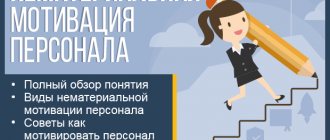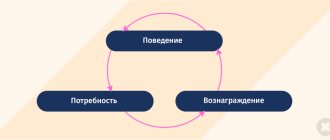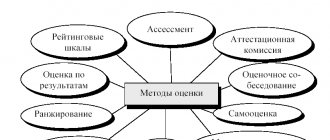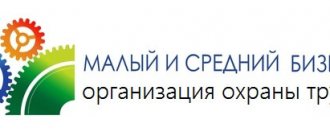What questions will you find answers to in this article?
- How to develop a staff motivation system
- Examples of staff motivation systems
- Why the staff motivation system may not work
When implementing a personnel motivation system, the General Director should not limit himself only to the position of the personnel service - he must take into account the needs of his employees. Thanks to a better understanding of your employees, the effectiveness of the organization's personnel motivation system will be much higher. In a small company, such measures are quite acceptable and simple, but in the practice of large enterprises they become much more complicated - a significant amount of work remains. In the work of such companies, it is recommended to combine different incentive methods. We will pay special attention to them in order to understand in more detail how to develop a motivation system for staff.
The meaning of staff motivation
The essence of the system under consideration is to develop the required behavior among employees, encourage them to increase productivity, and be interested in obtaining higher performance.
When talking about motivation, it is often equated with stimulation. However, these two concepts have clear differences.
- A stimulus is an external urge for one person to act on another.
- Motive is an internal attitude towards a particular action.
The process of motivation itself causes a person to compare an external image with an image of need.
Personnel motivation has the main goal of setting the mood for increasing labor productivity, and therefore increasing the company’s profits.
A motivated employee performs his or her job more efficiently, which brings high income to the company.
The motivational system is aimed at solving several problems at once.
- Promotes the development of professionalism and advanced training of employees.
- Optimizes personnel costs.
- Increases employee loyalty and prevents high staff turnover.
- Directs employees to actively participate in solving the company's strategic objectives.
- Helps to achieve high productivity of each employee.
- Attracts specialists with excellent professional level and many years of experience.
The process of creating a team of professionals occurs throughout the entire life of the company. Motivation must continue constantly, because over time there is a decline in employee interest and this is reflected in the results of their work.
The choice of possible motivation tools remains with the employer
There are material and non-material bases for this process.
Goals and objectives
The director must always adhere to certain goals when drawing up a motivational program.
The manager is obliged to pay attention to what the company needs, as well as what indicators he would like to get closer to. You can outline in general terms what will be included in the range of tasks and goals. Why you need motivation:
- Development of professionalism among existing employees, increasing labor efficiency.
- Increasing staff loyalty, reducing the number of layoffs.
- Approaching high levels of performance.
- Optimization of team costs.
- Attracting valuable personnel to the company.
The development of employee motivation systems is the responsibility of a development specialist. However, not every company has such an employee. Therefore, the director of the company or the head of the department is often involved in drawing up an incentive scheme. Considering the fact that developing a system is not so easy, it will be useful to use ready-made examples.
Scheme of material motivation at the enterprise
It cannot be argued that it is the material interest of workers that is the main driving force. However, it is distinguished by its versatility. Many employees are even willing to give up non-financial rewards in order to receive additional monetary income . The incentive payment system includes several components.
- Remuneration in accordance with employee achievements.
- Payment of bonuses: monthly, quarterly, for long-term work, cash prizes for special merits.
- Percentage of exceeded revenue plan for goods sold or services provided, additional payment for professionalism based on certification results.
- Bonuses. It is advisable not to use fixed amounts, but to vary them in accordance with the level of contribution of an individual employee to the general cause of the company.
Incentive rewards are also provided for the management team (bonuses). It is paid for a high contribution to improving the main financial indicators of the enterprise.
There is a team bonus for a separate structural unit for the most successful implementation or overfulfillment of the plan. Although in this case it is necessary to act very correctly so as not to demotivate other departments.
No matter how effective material types of incentives are, it is necessary to take into account other features of the attitude towards the work of team members. If you rely only on material incentives, this will not always have a beneficial effect on the moral and psychological state of the team.
Material motivation is a powerful incentive to encourage a person to work productively
Types of non-material employee incentives
There are generally accepted non-financial incentive schemes, but each company has specific features that require adjustment of standards.
An experienced leader knows that people perceive different methods of motivation differently. Of course, it is difficult to develop a separate scheme for each employee, especially if the team is quite large. In such cases, a generalized model is used that best meets the needs of employees.
More details about all the nuances and types of non-material incentives for employees:
Non-material encouragement can be expressed in the form of verbal gratitude in the presence of the team. But some methods require certain costs from the company, although the employee does not receive remuneration in the form of cash . Let's list these types of motivation.
- Carrying out corporate events.
- Congratulations to employees on anniversaries and other significant personal events.
- Issuance of company-paid health insurance.
- Help in the form of payment for treatment.
- Gifts from the company: tourist vouchers, vehicles.
- Providing free housing.
- Creation of ideal working conditions, installation of new computer equipment.
A properly built system of non-material motivation improves the psychological climate in the team and increases labor productivity
Selection of non-material motivation methods
When developing a system of non-material rewards, one should proceed from what the employees themselves consider most important to themselves. It should also be taken into account that non-material motivators are focused on a variety of individual needs, but there is a relationship between the key motives of the individual and elements of moral stimulation. For example, an employee with a strong achievement motivation will always strive for ambitious goals and work to improve the efficiency of his activities, while applying something new and unique that others have not done before.
For such people it is important:
- prospects for going beyond the limitations of the current position;
- opportunities for training, professional and career development;
- job responsibilities corresponding to qualifications and existing knowledge;
- recognition of one's own contribution to the success of the common cause;
- provision of necessary resources;
- encouragement for personal achievements;
- individual ambitious goals.
Individuals who seek to influence others will prefer:
- new prospects for career advancement;
- freedom and independence;
- provision of necessary resources;
- the ability to implement changes;
- focus on high goals.
Employees who strive for warm, friendly relationships with others see particular value in the motive of belonging. Since they try to be part of a social group, it is important for them:
- quality of relationships in the workforce;
- receiving feedback;
- flexible working conditions;
- encouragement for teamwork;
- balance between work and personal life;
- provision of necessary resources.
An effective motivation system must harmoniously combine all motivating factors. If the company's management manages to develop a unique motivational program and implement it, then over time the subordinates will become more loyal and proactive.
Forms of non-standard motivation in an organization
A sign of our time is a passion for everything new and unusual. You can see how effective creative thinking is; it is the engine of many life processes. The more creative a leader and his team are, the better results they can achieve .
Speaking about non-standard types of motivation, as an example, we can cite several successful finds.
- Unexpected presentation of a gift to the best employee. Send a thank you note via email.
- Sending a good employee on leave.
- Trust employees who have distinguished themselves with the most interesting and complex projects.
- Give employees the opportunity to independently choose projects and methods for solving assigned tasks.
- Reward the employee for not being sick. However, it is necessary to apply appropriate bonuses, for example, offering flu vaccinations at the company’s expense.
Methods that promote team unity and create a healthy moral and psychological atmosphere are also widely used. Company presentations that demonstrate the successes achieved through the diligence of team members are very effective.
Taking into account the results that different types of motivation can produce, we can conclude that they must be used in combination. To claim that one species has an advantage over another is a deep misconception. The main thing is to try to apply them taking into account the individual characteristics of individual employees, and to minimize the average approach.
Video: how to properly motivate company staff
Possible employee incentive options
Motivation models are classified according to the place of their use.
- American - designed for material incentives and bonuses (gym memberships, gifts, better working conditions, trips abroad, trainings, etc.).
- Western European - used only in case of high awareness of the employee. Bonuses can include: career advancement, a job in a branch of another city, professional courses, trainings, etc.
- Japanese, aimed at creating a spirit of collectivism. Priority is given to the dedication of employees to their company.
A separate type of motivation is the point system. Based on the points given, the employee’s ability is assessed, his main character traits in relation to work are revealed: ability to work, diligence, accuracy, accuracy.
Classic methods of non-material motivation
Ideally, each company should create and apply its own set of motivating tools, depending on the specifics of the activity, the nature of the team, and management style. Non-financial motivation will be successful only if the manager manages to find the “key” to each team member, that is, to study his self-motivation. Please note that all of the following motivators will work differently in different conditions. Even the length of an employee’s tenure matters. According to psychologists, after an employee has been in one position for more than five years, his degree of satisfaction with working conditions decreases.
Meetings, planning meetings, flights
Meetings allow employees to stay informed about what is happening and feel involved in the life of the company, so these key tools are great for creating conditions of ownership among the workforce.
Informing about the company's achievements and encouraging those who excel
Everyone loves kind words, especially if they express well-deserved praise. An employee can be praised in the presence of the team, in the corporate newspaper, or on the company website on the Internet.
Congratulations on significant events
The list of important dates can include the anniversary of work in the company, appointment to a new position, personal holidays of people (birthdays, weddings, receiving an academic degree, etc.). Such options for motivating employees open up wide scope for imagination when choosing a gift. This could be an award or a hand-drawn poster. But in any case, the gift must be presented in front of the entire team.
Competitions and competitions
Experience shows that staff are well motivated to participate in various competitions and competitions. For example, you can organize a competition for the title “Advanced Manager of the Quarter”, “Mr. Positive”, “Most Accurate Employee”, etc.
Personal work area
People are pleased when they are addressed by name and known by sight. Therefore, even a simple sign on the door or on the table can be a tool for non-monetary motivation.
Discounts on company goods or services
Discounts may be quite insignificant, but knowing that there is a narrow circle of people who have the opportunity to use them significantly increases confidence in management and in the enterprise.
Internal incentive events
Non-material employee incentives also include festive corporate banquets, group trips to the theater or football, and barbecue trips. Even a cleanup day in the office can be beneficial if you introduce a team-building game into it.
Education
Your subordinates should be encouraged by sending them to various internships, scientific conferences, and training courses. Driven employees usually love to grow.
Flexible schedule, organization of remote work
There are categories of positions whose presence at a stationary workplace is not necessary. In this case, it is necessary to establish the amount of work for such an employee and the minimum time he will be in the office during the work week.
The right to choose
The manager should consult with his staff on how and where to hold a corporate party, what method of incentive to choose - payment for gasoline costs, telephone costs, or something else. The best team members can be allowed to be the first to choose their vacation time.
Possibility of feedback
Company specialists should have the opportunity to speak out. They can do this by leaving their comments and recommendations on special boards with markers, in improvised letter boxes, and expressing their thoughts out loud at meetings. It is very important for people to understand that their opinion will be heard. Extra rewards can be given for unusual offers. In world practice, this is called awarding initiative.
Equipment for recreation areas
First of all, you need to take care of the space for storing outerwear and the kitchen area. You should have lunch not at your workplace, but in a special room where you can switch from a business environment to a cozy and, if possible, home environment. This method of encouragement has a positive effect on the emotional state of the team and, consequently, work activity.
Moral support in solving serious personal problems
If an employee experiences grief, you can provide him with leave with pay, organize a temporary individual schedule, and help in solving the problem. Conscientious employees always appreciate such actions on the part of management.
There are many different ways of non-material motivation. Each company can choose from them those that it considers the most effective, but the general set of motivators is approximately the same for all:
- benefits – reduction of working hours. Nowadays, a scheme is becoming popular in which employees are given the opportunity to use several days a year at their discretion;
- recognition of merit - career advancement and encouragement of those who actively helped the development of the company;
- corporate events - excursions, celebrations and other types of collective pastime create activities that have a positive effect on the quality of work;
- non-financial rewards - benefits, medical insurance, symbolic gifts, etc.
Development of a point system
The source for payment of incentives is taken as a basis, for example, it is 100 thousand rubles.
If an employee does not fulfill the plan, he is given 0 points, for conscientious implementation - 1 point. For all employees, the maximum score is 14, for the department - 42 points.
For example, after the assessment, the head of the department scored 11 points, the sales manager - 9, and the HR officer - 14.
A simple formula is used to calculate incentives.
Cash reward amount = payout fund/total points multiplied by the individual employee's points.
If a point system is used based on the results of their work activities, employees will receive the following bonuses:
- head of department - (100,000/42) x 11 = 26,190 rubles;
- sales manager - (100,000/42) x 9 = 21,428 rubles;
- HR officer - (100,000/42) x 14 = 33,333 rubles.
The use of a point system allows us to take into account the labor contribution of each employee and provide him with adequate remuneration for his work
Formation and improvement of the motivation system
To create an effective motivational system, you should know the basics of its structure and its constituent elements.
- Determining the main goal and key tasks.
- Development of company policy for the future, specifying the time frame for achieving the goal.
- Basic stimulating and motivating principles.
- System functionality.
- Structure (material, intangible and non-standard motivation).
- Technological features.
Before forming a system within the company, it is necessary to familiarize yourself with the situation of employee motivation:
The stages that the motivation system must go through are the same for all companies.
- It is necessary to decide on the main indicators that can reflect the employee’s performance.
- Drawing up and approval of the tariff schedule.
- Selection of tools that are planned to be used in the motivation process.
- A system for assessing the work of each employee.
- Performance-related performance and rewards.
An approximate diagram of step-by-step employee motivation is given below.
The financial incentive option is developed in accordance with the American MBA management standard
Step-by-step instructions for creating your own motivation system
- The head of the company communicates plans and tasks to team members.
- A detailed study of the personnel composition: age, specialization, experience, professionalism. Planning the use of non-material incentives.
- Analysis of motivation in similar companies. Select the most appropriate motivation options.
- Survey through a questionnaire of employees to determine the compliance of certain motivation methods.
- Informing employees about the introduction of a motivation system.
The KPI system is one of the most common models for motivating trade employees. Read more about the principles of its development and implementation at the link:
Diagnostics of model performance
The system does not exist on its own; it is not enough just to create it; it requires analysis and determination of how cost-effective the obtained indicators are.
A simple concept using a donkey as an example
Carrying out analysis of variance makes it possible to understand how much the system under consideration influences the results of employees’ work, and whether it is effective in changing their attitude towards work.
As you know, the company incurs certain costs for motivation, so it is very important to monitor whether economic feasibility is observed. In other words, an employee must bring more income to the company than the expenses spent on him.
Specific examples of creating successful motivating systems
The development and implementation of new motivational schemes is unthinkable without studying the positive experience accumulated in this area. In order to successfully implement the system you have come up with, you should carefully study already tested and well-proven examples of motivational schemes.
Examples of successfully working motivation systems adopted by large Russian companies are given below.
Involving employees to evaluate the performance of colleagues
Philip Rosedale, who founded Second Life, proposed creating a tool to collect information about employees' opinions of each other. As part of this program, everyone could write a message expressing their attitude, it could be admiration, recognition, verbal encouragement or criticism. All this information was public. Thus, an objective method of assessment was practically created, which is a component of the motivation system.
Optimization of the motivation system
One investment company was experiencing a decline in employee productivity and loyalty. Management decided to apply the following types of motivation:
- increasing the percentage of additional payments from exceeding the plan;
- issuing prizes, holding competitions for the best employee;
- introduction of KPIs;
- encouragement for taking initiative to solve company problems;
- holding holidays with the team with the participation of family members of employees.
As a result of monitoring the results of the implementation of the new system, it turned out that staff turnover stopped and labor productivity increased.
Building a clear motivational model
A well-known company with a solid image constantly develops, reviews and improves its motivation system. To preserve and establish one’s image, it was decided to use only 2 motivation options.
- Material incentives - salary increases, bonuses for exceeding the plan, bonus payments, bonuses every quarter and annual social payments.
- Intangible - holding corporate events where the best employees are rewarded.
The result is obvious - this company has not lost its popularity and remains economically stable.
The effectiveness of an integrated approach
The company that creates games for cryptocurrency mining has set itself the goal of securing highly qualified specialists with a rare specialization in the team. To do this, they were involved in interesting projects that were highly complex. However, management showed special trust in professionals. In addition, high pay was promised for this work and a flexible schedule was offered. Comfortable working conditions were also created for them. As a result, all valuable employees showed interest and continued working in this company.
How to develop a competent motivational system
In the construction industry, reorientation of activities was required due to changes (increase) in the scale of work. For these purposes, material motivation was used: expanding the volume of incentive payments, introducing bonuses and incentive gifts. Non-material incentives: informing employees about the main objectives and strategy of the company, holding collective events, showing trust from management. Thanks to this, the company was able to cope with the task.
Gifts for employees and a well-organized corporate event are effective non-material motivation
Where to get help in motivating and stimulating staff - review of the TOP 3 companies
What to do if your own skills in developing a motivation system are not enough?
Turn to third-party resources. That is, find a company that provides professional business training or compiles motivation systems for various institutions.
1) Moscow Business School
The company has existed for only 5 years, but already occupies a leading position in the field of business education in the Russian Federation. Specialists and practitioners of the highest level conduct seminars, courses and trainings in all areas of business.
A dynamic business environment requires constant change and a flexible approach to the training system. Therefore, domestic and foreign specialists who develop educational programs here constantly use current market development trends.
Training is conducted in open and corporate formats. The business school also offers training in the most modern format - through webinars and video courses.
2) Volgasoft
This consulting company has richer experience, having been working in the business market for 18 years. Here they will help solve the most complex management issues and increase the efficiency of any institution.
The company offers a unique training program “Management by Objectives and KPIs”, which takes into account all modern business trends. Thanks to this methodological complex, an effective management system is built for any business model.
In addition, you will find:
- practical methods for managers to motivate staff;
- consulting services;
- seminars, webinars and other training events.
Study conditions, offers and tariffs on the company’s website.
3) MAS Project
“Pay employees for results, not for presence,” says the main slogan of the management system proposed by this company.
Experienced MAS Project specialists have developed a business efficiency system that combines project and task management, time, interaction and other planning tools.
The system offers you more than 30 tools to increase the efficiency of your enterprise, increase profitability, and develop the company and each individual employee.
The website contains videos with visual examples of using the MAS Project system. In the near future, a mobile application will appear there for ease of working with the program.










